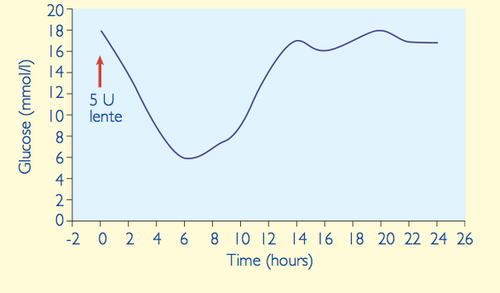Difference between revisions of "Feline Medicine Q&A 03"
Ggaitskell (talk | contribs) (Created page with "{{Template:Manson Sparkes}} [[Image:|centre|500px]] <br /> '''The graph shows the blood glucose results obtained from a 6 kg diabetic cat which is being treated in hospital wi...") |
Ggaitskell (talk | contribs) |
||
| (2 intermediate revisions by 2 users not shown) | |||
| Line 1: | Line 1: | ||
{{Template:Manson Sparkes}} | {{Template:Manson Sparkes}} | ||
| − | [[Image:|centre|500px]] | + | [[Image:Feline Medicine 03.png|centre|500px]] |
<br /> | <br /> | ||
| Line 14: | Line 14: | ||
The glucose curve suggests that the cat is insulin resistant. <br><br> | The glucose curve suggests that the cat is insulin resistant. <br><br> | ||
Insulin resistance is usually defined as being present in cats remaining hyperglycaemic and glycosuric in spite of receiving >1.5 U of insulin per kg bodyweight per dose, or in cats requiring >2.2 U/kg to maintain glycaemic control. | Insulin resistance is usually defined as being present in cats remaining hyperglycaemic and glycosuric in spite of receiving >1.5 U of insulin per kg bodyweight per dose, or in cats requiring >2.2 U/kg to maintain glycaemic control. | ||
| − | |l1= | + | |l1=Diabetes Mellitus#Instability |
|q2=What differential diagnoses need to be considered? | |q2=What differential diagnoses need to be considered? | ||
|a2= | |a2= | ||
| Line 28: | Line 28: | ||
Acromegaly and HAC are important causes of more severe insulin resistance. Other endocrine tumours (islet cell glucagonoma, phaeochromocytoma) are rare potential causes of marked insulin resistance. <br><br> | Acromegaly and HAC are important causes of more severe insulin resistance. Other endocrine tumours (islet cell glucagonoma, phaeochromocytoma) are rare potential causes of marked insulin resistance. <br><br> | ||
Improper storage and handling of insulin may also be a cause of apparent insulin resistance. | Improper storage and handling of insulin may also be a cause of apparent insulin resistance. | ||
| − | |l2= | + | |l2=Diabetes Mellitus#Instability |
</FlashCard> | </FlashCard> | ||
Latest revision as of 07:54, 1 October 2011
| This question was provided by Manson Publishing as part of the OVAL Project. See more Feline Medicine questions |
The graph shows the blood glucose results obtained from a 6 kg diabetic cat which is being treated in hospital with 20 U of lente insulin once daily. Normal blood glucose concentrations would be between 3.5–7.5 mmol/l (63–135 mg/dl).
| Question | Answer | Article | |
| What is the assessment of this case? | The glucose curve suggests that the cat is insulin resistant. |
Link to Article | |
| What differential diagnoses need to be considered? | Mild insulin resistance can be seen with a variety of physiological and pathological conditions including dioestrus, pregnancy, and severe obesity.
Affected cats generally demonstrate variable or continuously poor control of their diabetes. |
Link to Article | |
